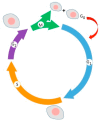The Potential Use of Resveratrol for Cancer Prevention
- PMID: 31835371
- PMCID: PMC6943596
- DOI: 10.3390/molecules24244506
The Potential Use of Resveratrol for Cancer Prevention
Abstract
In addition to the traditional treatments of cancer and cancer prevention, the use of natural compounds, especially those found in food, should be considered. To clarify if resveratrol has the potential for cancer prevention and the possibility of use in therapy, the following must be taken into account: data from epidemiology, clinical protocol (case and control), preclinical studies (lab animals), use of established cell lines as models of cancer cells, test tube assays (enzymes activities), and requirements of nanotechnologies in order to discover new drugs to fight cancer. From this perspective and future expected advances, more information is needed such as improved efficacy, methods of application, and the synergistic sensitization of resveratrol as an adjuvant. In addition, resveratrol nanoformulation is considered to overcome its weak bioavailability.
Keywords: approach strategies; cancer; innovative formulations; mechanisms; prevention; resveratrol.
Conflict of interest statement
The authors declare no conflict of interest.
Figures
References
-
- Duee P.-H., Gerber M., Latino-Martel P., Latruffe N., Pecollo N. Nutrition & Cancer. [(accessed on 9 December 2019)]; Available online: https://www6.inra.fr/nacre/content/download/3460/36662/file/Rapport-nutr....
-
- Villarini M., Lanari C., Nucci D., Gianfredi V., Marzulli T., Berrino F., Borgo A., Bruno E., Gargano G., Moretti M., et al. Community-based participatory research to improve life quality and clinical outcomes of patients with breast cancer (DianaWeb in Umbria pilot study) BMJ Open. 2016;6:e009707. doi: 10.1136/bmjopen-2015-009707. - DOI - PMC - PubMed
-
- Le Corre L. Ph.D. Thesis. Université de Clermont-Ferrand; Clermont-Ferrand, France: 2005. Resvératrol et Cancer du Sein: Biodisponibilité-Régulation Transcriptionnelle.
Publication types
MeSH terms
Substances
LinkOut - more resources
Full Text Sources
Miscellaneous




